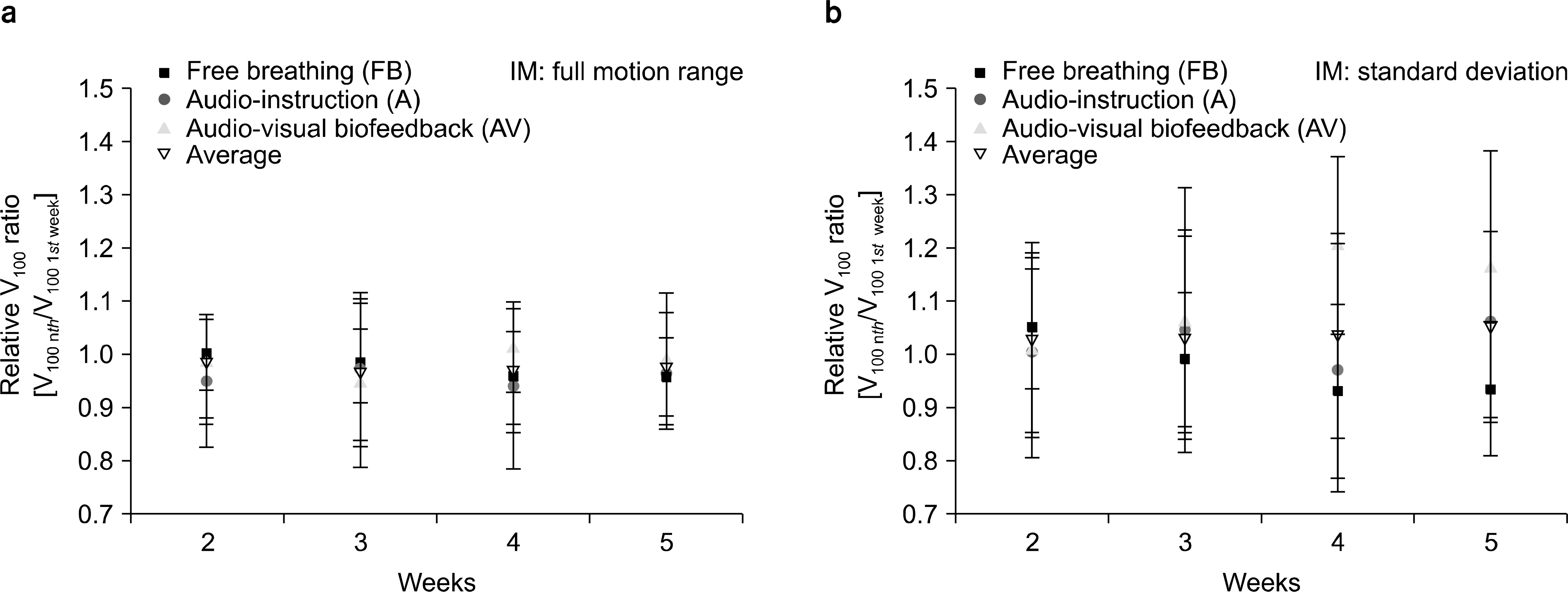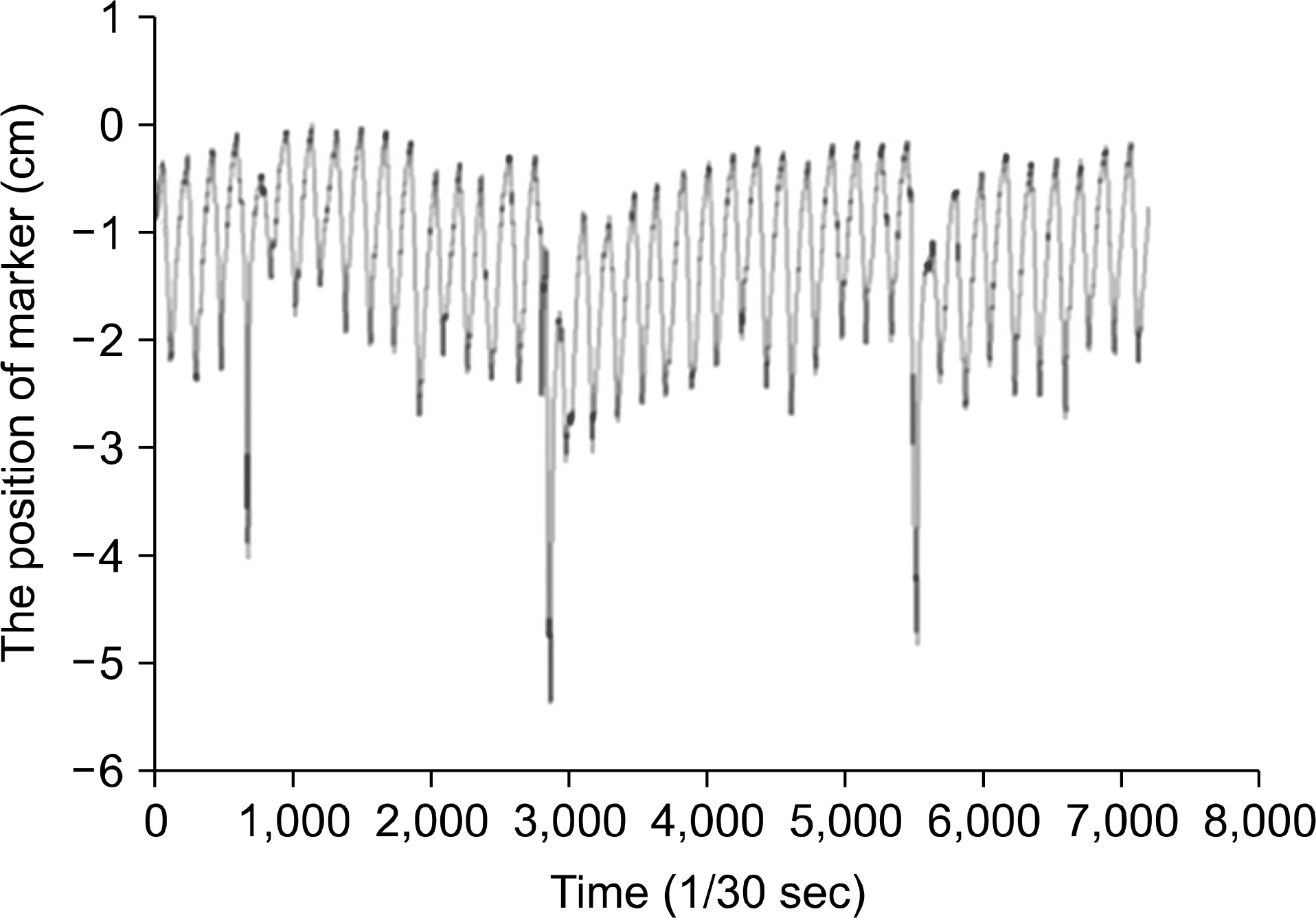Prog Med Phys.
2013 Sep;24(3):135-139. 10.14316/pmp.2013.24.3.135.
The Effect of Breathing Biofeedback on Breathing Reproducibility and Patient's Dose in Respiration-gated Radiotherapy
- Affiliations
-
- 1Department of Radiation Oncology, Gachon University Gil Medical Center, Incheon, Korea.
- 2Department of Radiation Medicine, Loma Linda University Medical Center, Loma Linda, CA, USA.
- 3Department of Physics, East Carolina University, Greenville, NC, USA.
- 4Department of Radiation Oncology, School of Medicine, Ewha Womans University, Seoul, Korea. heraash@hanmail.net
- KMID: 1910576
- DOI: http://doi.org/10.14316/pmp.2013.24.3.135
Abstract
- We evaluated the effect of two kinds of breathing biofeedback technique such as audio-instruction and audio-visual biofeedback on breathing reproducibility and the CTV coverage during repeated treatment regimes in respiration-gated radiotherapy. In this study, the breathing data of nineteen lung cancer patients acquired from Medical College of Virginia (MCV) during five weeks were used. The dose evaluation algorithm was programmed in MATLAB. In the result, the CTV coverage was decreased as 30.0% due to the breathing irreproducibility for free-breathing. For audio-visual biofeedback, the CTV coverage was improved as 20.0% because patients can learn how control their breathing stably. And the audio-instruction was effective to preserve the breathing reproducibility.
Figure
Reference
-
1. Barnes EA, Murray BR, Robinson DM, Underwood LJ, Hanson J, Roa WH. Dosimetric evaluation of lung tumor immobilization using breath hold at deep inspiration. International Journal of Radiation Oncology Biology Physics. 50(4):1091–1098. 2001.
Article2. Bethesda. ICRU Report. 50:Prescribing, Recording, and Reporting Photon Beam Therapy. International Commission in Radiation Units and Measurements. 1993.3. Briere TM, Beddar S, Balter P, et al. Respiratory gating with EPID-based verification: the MDACC experience. Physics in Medicine and Biology. 54(11):3379–3391. 2009.
Article4. Fuji H, Asada Y, Numano M, et al. Residual motion and duty time in respiratory gating radiotherapy using individualized or population-based windows. Int J Radiat Oncol Biol Phys. 75(2):564–570. 2009.
Article5. Nicolini G, Vanetti E, Clivio A, Fogliata A, Cozzi L. Pre-clinical evaluation of respiratory-gated delivery of volumetric modulated arc therapy with RapidArc. Phys Med Biol. 55(12):347–357. 2010.
Article6. Berbeco RI, Neicu T, Rietzel E, Chen GT, Jiang SB. A technique for respiratory-gated radiotherapy treatment verification with an EPID in cine mode. Phys Med Biol. 50(16):3669–3679. 2005.7. Mori S, Yanagi T, Hara R, et al. Comparison of respiratory- gated and respiratory-ungated planning in scattered Carbon ion beam treatment of the pancreas using four-dimensional computed tomography. Int J Radiat Oncol Biol Phys. 76(1):303–312. 2010.8. George R, Chung TD, Vedam SS, et al. Audiovisual biofeedback for respiratory-gated radiotherapy: Impact of audio-instruction and audiovisual biofeedback on respiratory-gated radiotherapy. Int J Radiat Oncol Biol Phys. 65(3):924–933. 2006.9. Muralidhar KR, Murthy PN, Mahadev DS, Subramanyam K, Sudarshan G, Raju AK. Magnitude of shift of tumor position as a function of moderated deep inspiration breath-hold: An analysis of pooled data of lung patients with active breath control in image-guided radiotherapy. J Med Phys. 33(4):147–153. 2006.
Article10. Tarohda TI, Ishiguro M, Hasegawa K, et al. The man agement of tumor motions in the stereotactic irradiation to lung cancer under the use of Abches to control active breathing. Med Phys. 38(7):4141–4146. 2006.11. Brock J, McNair HA, Panakis N, Symonds-Tayler R, Evans PM, Brada M. The use of the active breathing coordinator throughout radical non-small-cell lung cancer (NSCLC) radiotherapy. Int J Radiat Oncol Biol Phys. 81(2):369–375. 2006.
Article12. Yang J, Yamamoto T, Cho B, Seo Y, Keall PJ. The impact of audiovisual biofeedback on 4D PET images: Results of a phantom study. Med Phys. 39(2):1046–1057. 2012.
Article13. Peter HC. Video-coaching as biofeedback tool to improve gated treatments: Possibilities and limitations. Z Med Phys. 22(3):224–230. 2012.14. Kim T, Pollock S, Lee D, O'Brien R, Keall P. Audiovisual biofeedback improves diaphragm motion reproducibility in MRI. Med Phys. 39(11):6921–6928. 2012.
Article
- Full Text Links
- Actions
-
Cited
- CITED
-
- Close
- Share
- Similar articles
-
- Quasi-breath-hold (QBH) Biofeedback in Gated 3D Thoracic MRI: Feasibility Study
- The Effect of Breathing Biofeedback Training in the Stress of Nursing Student in Clinical Practice
- Efficacy of a Respiratory Training System on the Regularity of Breathing
- Comparison between audio-only and audiovisual biofeedback for regulating patients' respiration during four-dimensional radiotherapy
- The Effects of Abdominal Relaxed Breathing Exercises using Biofeedback on Stress Response and Blood Pressure in Elderly People with Hypertension





